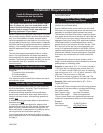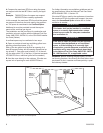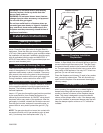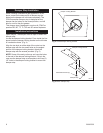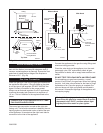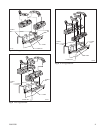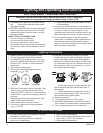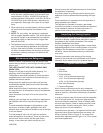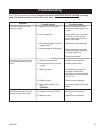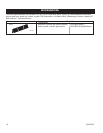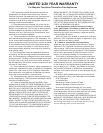
1320002538
When Used as a Heating Appliance
1. This appliance is equipped with a modulating valve
which provides variable control of heat output, from
approximately 15,000 or 18,000 BTU/hr at the full
counterclockwise LOW position, to 24,000, 32,000 or
35,000 BTU/hr at the HIGH position, depending on
your appliance. See page 3 for output of your appli-
ance.
2. When used as an unvented heater, maximum benefit
will result when the fireplace flue damper is fully
closed.
3. NOTE: For your safety, the appliance is equipped
with an oxygen depletion sensor. This device senses
the level of oxygen in the atmosphere and switches
off the gas supply in case the level of oxygen falls
below a safe level.
4. The appliance may be used as a heating appliance
only if unvented heating appliances are permitted
by local, state and city codes. In locations that do
not allow unvented heaters, the chimney must have
a permanent chimney opening of not less than 29
square inches.
Maintenance and Safeguards
Keep the control compartment, logs and burner area
around the logs clean by vacuuming or brushing at least
twice a year.
THE LOGS CAN GET VERY HOT. HANDLE ONLY
WHEN COOL.
Always turn off gas to the pilot before cleaning. For
relighting, refer to the lighting instructions.
The appliance and venting system (if used) should be
inspected before initial use and at least annually by a
qualified field service person.
Always keep the appliance area clear and free from
combustible materials, gasoline and other flammable
vapors and liquids.
Never obstruct the flow of combustion and ventilation
air. Keep the front of the appliance clear of all obstacles
and materials.
Leave clearance of at least 36” from the front of the
fireplace.
Although your gas logs are very realistic in appearance,
the fireplace must not be used for burning any solid
fuels.
To avoid irreparable damage to the appliance or per
-
sonal injury, matches, paper, garbage or any other
material must not be placed or thrown on top of the logs
or into the flames.
To avoid personal injury, do not touch hot surfaces
when the appliance is operating. Touch only the valve
control knob. Avoid contact with the grate feet or
prongs, or any other part which may be very hot.
Always ensure that the fireplace screen is closed when
the appliance is operating.
Any safety screen or guard removed for servicing the
appliance must be replaced before operating the appli-
ance.
Close supervision is necessary when the appliance is
being operated near children.
The appliance is intended for use as a gas heater
mounted in a vented or unvented fireplace as described
in the installation sections of these instructions. It
should not be used for any other purpose.
Inspecting the Venting System
A vented fireplace venting system is designed and con-
structed to develop a positive flow adequate to remove
flue gasses to the outside atmosphere. See vented
fireplace installation instructions.
Any foreign objects in the venting system, except those
designed specifically for the venting system, may cause
spillage of the flue gasses into the room. In extreme
situations, carbon monoxide poisoning or suffocation
may occur.
Periodic examination and cleaning of the venting
system of the solid-fuel burning fireplace must be done
frequently by the home owner or a qualified agency.
VL System Maintenance
The VL burner/control systems consist of:
• Chassis
• Gas Orifice
• Grate Assembly
• VL18 - four (4) decorative gas logs
VL21 - five (5) decorative gas logs
VL24 - six (6) decorative gas logs
• Gas Valve Assembly
• Pressure Regulator
Most of these components require only occasional
checkup and cleaning. Some may require adjustment. If
repair is required, it should be performed by a qualified
technician.
In order to properly clean the burner and pilot assembly,
turn off the gas to the unit, remove the logs exposing
the burner and pilot assembly. Clean all foreign materi-
als from top of burner. Check to make sure that burner
parts are clean. Visually inspect pilot. Brush or blow
away any dust or lint accumulations.
To obtain proper operation, it is imperative that the pilot
and main burner flame characteristics are steady, not
lifting or floating. Refer to Figure 10 for proper main
burner flame appearance and Figure 11 or 12 for proper
pilot flame appearance.



